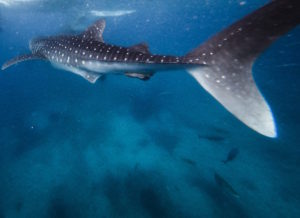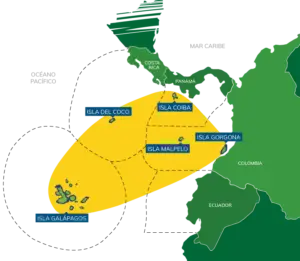Diving with Whale Sharks in Coiba: Understanding the Wonders and Responsibilities

Being the northern pillar of the Tropical East Pacific Corridor lies Coiba island, off Panama’s Pacific coast – a hidden gem for divers. This pristine region offers a remarkable opportunity to witness the awe-inspiring grace of the world’s largest fish species: the whale shark. In this blog post, we will explore some facts of diving with whale sharks in the Coiba region, shedding light on their conservation status, unique characteristics, and the importance of responsible interaction.

Whale Shark Biology
Before venturing into the water, it is essential to understand the incredible characteristics that make whale sharks such captivating creatures. These gentle giants, reaching lengths of up to 14 meters / 50 feet, boast a unique checkerboard pattern on their backs and can weigh over 20 tons. Their diet primarily consists of plankton and small marine organisms, earning them the title of filter-feeders, a toothless shark. They are inhaling over 6,000 liters of water an hour with their mouths stretching more than 1 meter wide? These gentle giants can live over 100 years, but sadly, only 10% reach adulthood due to human fishing practices. These fascinating creatures are known for their docile behavior and gentle nature, making encounters with them incredibly enriching experiences.
Whale Shark Migratory Patterns and Population Size
The Tropical East Pacific Corridor, including the waters around Coiba, serves as a crucial hub for the annual migration of whale sharks. Recent studies indicate that these magnificent creatures can be observed in the region mainly from December to April, following a predictable route along the coast between Coiba in Panama and Gorgona island in Colombia. While precise population estimates remain challenging, researchers have noted fluctuations in the number of sightings in recent years, highlighting their continued presence and migratory patterns. We had seen and photographed whale sharks here, which have been identified up as far as Mexico. But whale sharks cannot only be seen between January and April, they can be frequently spotted with some look through-out the year especially after full moons.
Conservation Status: A Call for Responsibility
Despite their immense size, whale sharks are classified as vulnerable by the IUCN Red List. While conservation efforts are in place, the continuous threats of overfishing, pollution, and detrimental interactions with humans pose serious challenges. It is vital to approach these encounters responsibly to ensure the long-term survival of these fascinating creatures and their ecosystems.
Responsible Interaction: Rules and Good Practices
Marine protection areas have established guidelines to facilitate responsible diving with the whale sharks. These regulations emphasize the importance of maintaining a respectful distance, avoiding any harassment or harm, and preserving the natural behavior of the sharks. By adhering to these rules and practicing responsible behavior, divers can leave a positive impact on these animals and ensure their well-being.
Here are some key points to consider:
- Maintain a distance of 250 meters of boats around the whale shark.
- Do not swim closer than 3 meters from the head and 4 meters from the tail.
- Avoid touching the whale sharks or any other form of direct contact.
- Minimize disturbance by not trying to keep up with the whale shark.
- Don’t block its path of travel.Real-Life Experiences: Tales of Wonder and Respect
Numerous divers have had the privilege of encountering whale sharks in Coiba while adhering to responsible guidelines. These encounters often elicit awe and appreciation for the wonders of the marine world. By sharing stories and anecdotes from these experiences, we aim to inspire divers to seek similar encounters and promote responsible behavior that prioritizes the conservation of these magnificent creatures.
Conclusion
Diving with whale sharks in the Coiba region allows individuals to witness the awe-inspiring beauty and grace of these gentle giants firsthand. However, it is essential to approach such encounters responsibly, as the conservation of these creatures and their habitats relies on our actions. By adhering to established rules, respecting their natural behavior, and spreading awareness, divers can contribute to long-term conservation efforts and ensure future generations can also marvel at these incredible creatures. So, let’s dive responsibly and conserve the unique wonders that lie beneath the surface.
